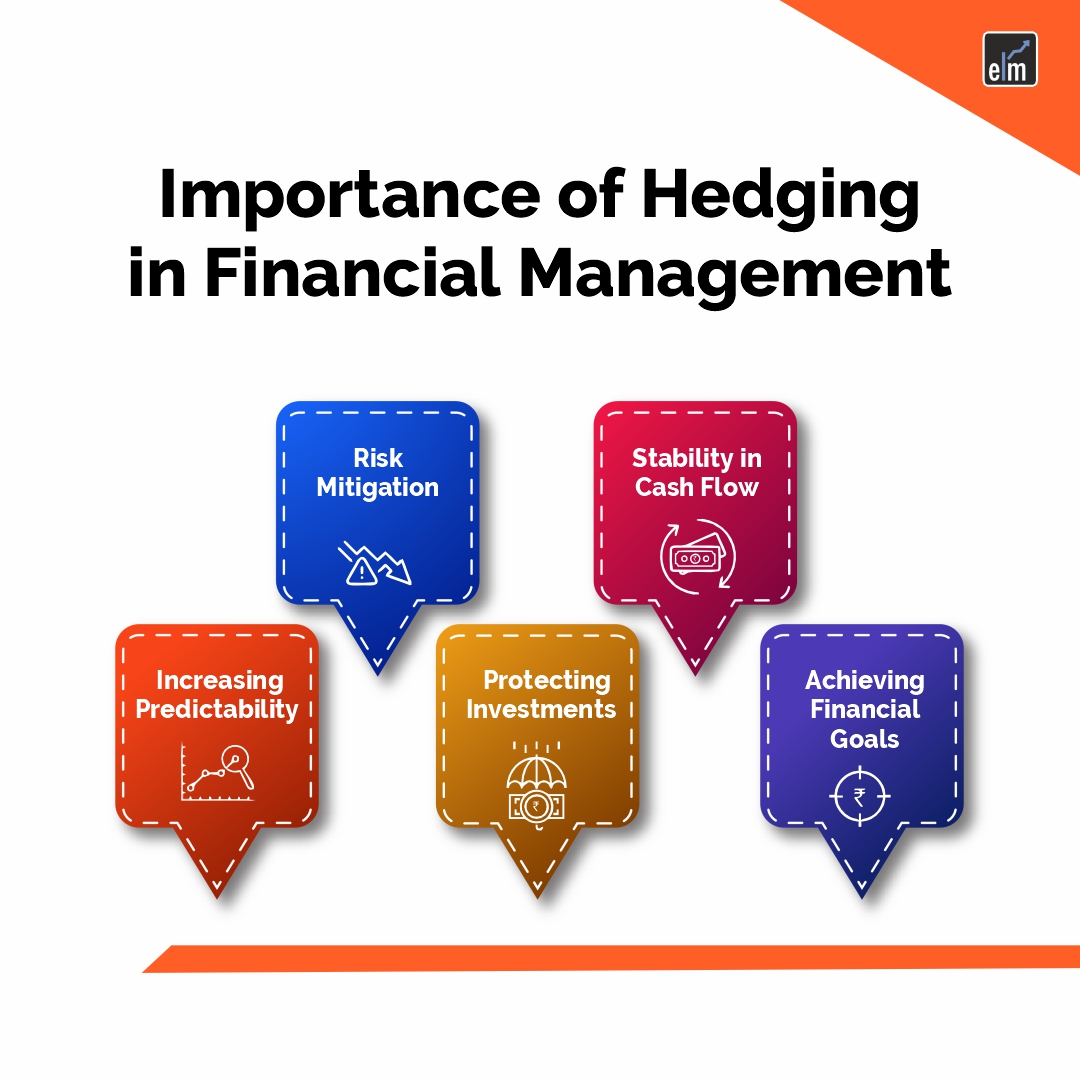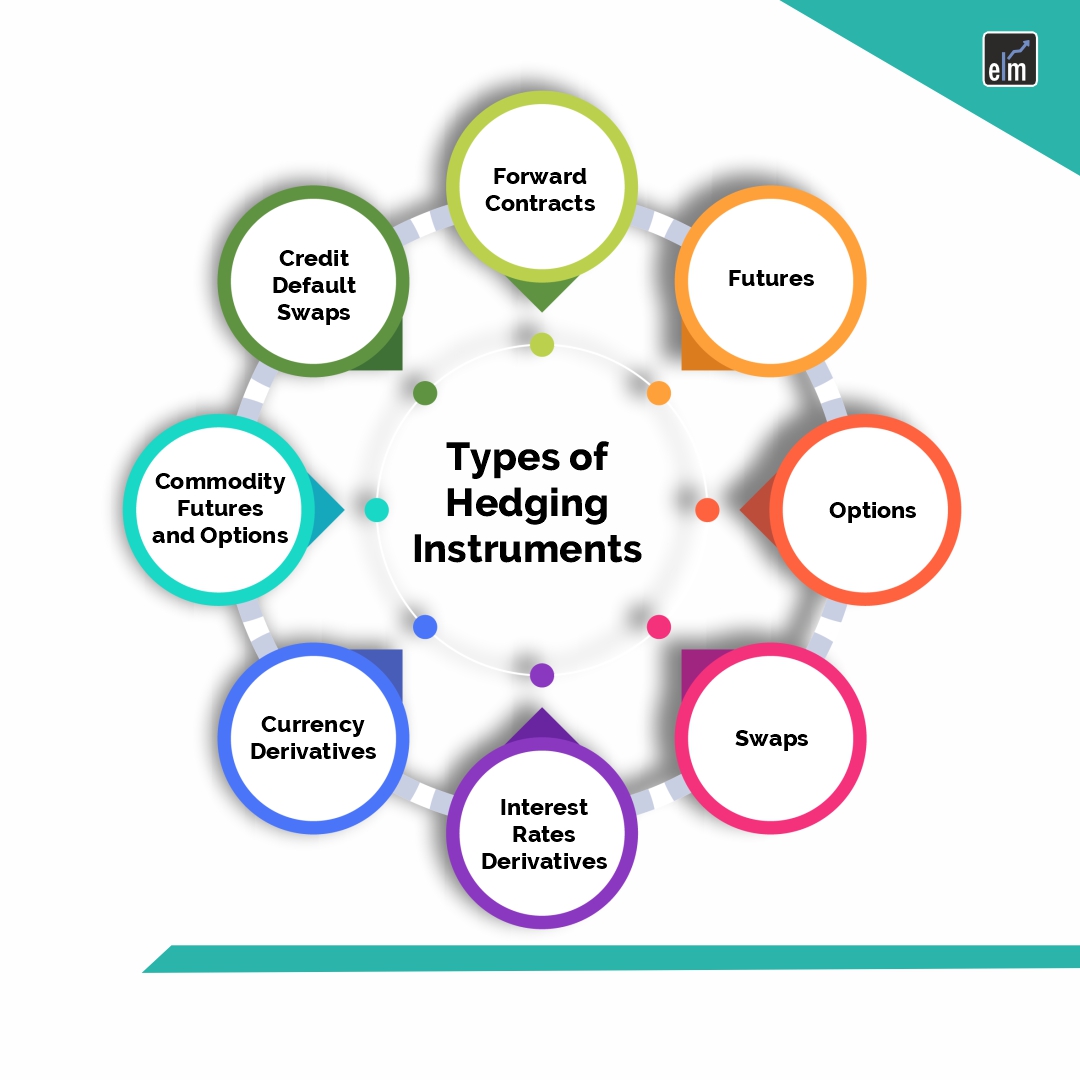Individuals, companies, and investors use hedging strategies as a financial technique to lessen or balance the impact of possible financial risks. It entails taking proactive steps to guard against unfavourable changes in interest rates, commodity prices, asset prices, foreign exchange rates, and other financial variables.
Hedging’s main goal is to lessen the volatility and uncertainty around these factors, which eventually protects the financial health of organizations involved in a range of economic activities.
Hedging is a risk management strategy that uses financial tools or approaches to reduce or completely eliminate the possibility of suffering losses due to adverse price changes or market oscillations.
Entities seek to strike a balance between protecting themselves from negative risk and enabling them to take advantage of favourable market circumstances by using hedging strategies-
- What is the Importance of Hedging in Financial Management?
- Understanding Risk in Financial Markets
- What are the Types of Hedging Instruments?
- Types of Hedging Strategies
- Risks and Challenges in Hedging Strategies
- Conclusion
- Frequently Asked Questions (FAQs)
What is the Importance of Hedging in Financial Management?
In financial management, hedging strategies are essential for a number of reasons-

- Risk Mitigation: Due to the inherent volatility of financial markets, investors and organizations are exposed to a range of risks. By taking a proactive approach to risk management, hedging lowers the possibility of experiencing financial losses as a result of unfavourable market fluctuations.
- Stability in Cash Flow: Changes in commodity prices and exchange rates can have an effect on cash flows for companies, particularly those that operate internationally. Hedging guards against the detrimental effects of volatility in commodity and currency prices, which helps to stabilize cash flows.
- Increasing Predictability: By hedging, organizations are able to project their finances more precisely. Businesses can boost their trust in their financial planning and decision-making procedures by mitigating the effects of erratic market dynamics.
- Protecting Investments-Hedging techniques are used by investors to protect their investment portfolios from market declines. This is especially crucial if you own assets that are susceptible to market swings or are living through unpredictable economic times.
- Achieving Financial Goals: By offering a methodical and planned approach to risk management, hedging helps achieve larger financial goals. Hedging helps people reach their financial objectives by safeguarding cash and guaranteeing debt repayment capacity and profit margins.
Understanding Risk in Financial Markets
Due to their intrinsic dynamic nature, financial markets are subject to a wide range of events that may cause price volatility and uncertainty. Comprehending and handling diverse forms of risks are essential elements of making financial decisions for individuals, enterprises, and investors. The main facets of risk in financial markets are examined in this section.
- Market Risks: Participants in financial markets are subject to a variety of hazards. For risk management to be effective, these hazards must be identified and categorized. The following are the main market risks:
- Interest Rate Risk: Changes in interest rates have an effect on borrowing costs, fixed-income assets’ values, and the state of the economy as a whole. Interest rate risk affects both businesses and investors, particularly when working with loans, bonds, and other interest-sensitive securities.
- Currency risk, often known as exchange rate risk, affects both investors and companies who trade internationally and hold assets denominated in foreign currencies. The value of investments, revenues, and expenses for global corporations can all be impacted by fluctuations in exchange rates.
- Commodity Price Risk: Sectors that rely on commodities for their operations, such as mining, energy, and agriculture stocks, are vulnerable to price fluctuations. Commodity price fluctuations have an effect on production expenses, earnings, and profitability.
- Equity Risk: Often referred to as stock market risk, equity risk is brought on by fluctuations in stock values. Stock portfolio owners are vulnerable to market downturns, which could reduce the value of their holdings.
Explore how gamma scalping can be used in options trading strategies.
What are the Types of Hedging Instruments?
Hedging is the process of mitigating or reducing the impact of any losses resulting from changes in the market through the use of financial instruments or methods.
Different kinds of risks are managed using different types of hedging strategies. The following are a few typical categories of hedging tools:

1. Forward Contracts
Agreements to purchase or sell an item at a future date for a price agreed upon today are known as forward contracts. Forward contracts are frequently customized contracts traded over-the-counter (OTC), unlike futures.
Application in Hedging- To protect against potential changes in the value of assets such as commodities, currencies, and other assets, forwards are used. They offer contract terms that are flexible.
2. Futures
Contracts for futures are arrangements between two parties to purchase or sell an asset at a predetermined price and date in the future. Standardized contracts are exchanged on designated exchanges.
Use in Hedging: Futures contracts are often used to hedge against price swings in commodities, currencies, interest rates, and stock indices.
3. Options
The right, but not the responsibility, to purchase (call) or sell (put) the underlying asset at a fixed price prior to or on expiration is granted to the holder of an option.
Use in Hedging: Options are adaptable mechanisms for hedging against changes in price. They give hedgers the chance to maintain gains while limiting possible losses.
4. Swaps
Swaps are transactions in which two parties exchange financial instruments or cash flows. Swaps of interest rates, currencies, and commodities are common varieties.
Use in Hedging: Interest rate, currency rate, and commodity price risks are managed through the use of swaps. They give parties the option to adjust how much risk they take on.
5. Interest Rates Derivatives
Interest rate swaps, floors, and caps are examples of interest rate derivatives. To control interest rate risk, these are employed.
Interest rate derivatives are frequently used by businesses and investors as a hedge against interest rate swings, shielding them from unfavourable changes in borrowing costs.
6. Currency Derivatives (Foreign Exchange Hedging)
Currency risk is mitigated by the use of currency derivatives, such as currency futures and options.
Application in Hedging- Currency derivatives are a tool used by investors and multinational corporations exposed to foreign exchange risk to lessen the impact of currency changes on their financial positions. Also known as foreign exchange hedging.
7. Commodity Futures and Options
Options and futures Commodity contracts enable hedging against changes in the price of commodities such as gold, oil, and agricultural products, among others.
Application in Hedging – These derivatives are used by businesses engaged in the production, delivery, or consumption of commodities to control price volatility.
8. Credit Default Swaps
Financial derivatives such as credit default swaps let an investor “swap” or balance their credit risk against another investor’s.
Use in Hedging: CDS can be used by investors as a hedge against the risk of loan or bond default.
Types of Hedging Strategies
Let us discuss some hedging techniques–
1. Interest Rate Hedging Strategies
Strategies for interest rate hedging are essential for controlling the risks brought on by changes in interest rates. Using efficient hedging techniques can assist reduce potential financial losses, regardless of whether you are an investor looking to protect against falling rates or a borrower susceptible to increases in interest rates. Interest rate futures and swaps are two frequently utilized securities for interest rate hedging.
Interest Rate Hedging Strategies
Interest rate swaps are financial agreements in which two parties exchange cash flows for a predetermined notional sum.
In a floating rate swap, one party pays a fixed interest rate and the other a floating rate, usually determined by a reference rate such as LIBOR.
Swaps offer flexibility in managing interest rate exposure by allowing variable interest payments to be converted into fixed payments or vice versa.
Interest Rate Futures Hedging Strategies
Standardized contracts that let parties lock in future interest rates are called interest rate futures.
Rate Locks with Futures: By using interest rate futures, investors can safeguard against future rate hikes by securing a predefined interest rate for a future time.
Interest rate futures can be used by traders as a means of speculative hedging.
Hedging strategy involves minimizing potential losses by offsetting risks through strategic investment positions, helping to protect against adverse market movements.
2. Currency Hedging Strategies
Numerous factors, such as market sentiment, geopolitical events, and economic data, affect currency values.
Currency risk can have an impact on expenses, income, and overall profitability for businesses that trade internationally.
Forward Contracts for Currency Hedging
An agreement to purchase or sell a predetermined quantity of money at a future date and exchange rate is known as a forward contract.
By enabling companies to fix exchange rates in advance, forward contracts help reduce the risk associated with currency fluctuations.
Forward contracts offer flexibility in managing currency exposure by allowing terms to be tailored to particular transaction needs.
Currency Options
Currency options grant the holder the right, but not the responsibility, to purchase (call option) or sell (put option) a predetermined quantity of currency within a given time frame at a predetermined exchange rate.
Options give users the ability to profit from positive changes in exchange rates while lowering the risk of negative outcomes.
Although there is an initial premium associated with options, beyond that amount, they provide insurance against unfavourable fluctuations in currency rates.
Combining Options and Forward Contracts
Some organizations build a tiered strategy to currency risk management by combining forward contracts and options.
As an illustration, a business may utilize options for more unpredictable exposures and forward contracts for predictable transactions to strike a compromise between cost and flexibility.
3. Commodity Price Hedging Strategies
Businesses and investors in industries where the price of goods or raw materials is directly affected by swings in commodity prices must engage in commodity price hedging. Avoiding negative financial effects can be achieved by managing the risks brought on by the volatility of commodities prices. Futures contracts and options are two frequently used tools for hedging commodity price fluctuations.
Futures Contracts for Commodities Hedging Strategies
A futures contract for buying or selling a certain amount of a good at a fixed price at a later time is called a futures contract.
In order to provide predictability in the face of erratic commodities markets, businesses might utilize futures contracts to lock in pricing for upcoming purchases or transactions.
By reflecting market expectations and assisting participants in making well-informed hedging decisions, futures markets aid in price discovery.
Options in Commodity Hedging Strategies
The right, but not the responsibility, to purchase (call) or sell (put) a certain amount of a commodity at a predefined price within a predetermined time period is granted to the holder of a commodity option.
Options give hedgers flexibility by lowering downside risk and enabling them to profit from favourable price moves.
Although there is an initial premium associated with options, this premium is offset by the protection they offer against unfavourable changes in commodity prices.
4. Equity Hedging Strategies
Geopolitical events, economic conditions, and other reasons can cause volatility in the equity markets.
During market downturns, investors, particularly those with concentrated equity holdings, run the danger of suffering substantial losses.
Stock Index Futures
Standardized contracts known as stock index futures enable investors to purchase or sell a basket of equities that is represented by a certain stock market index at a fixed price at a later time.
By taking positions that balance out possible losses in their equity portfolios, investors can use stock index futures as a hedge against market falls.
By offering leverage, futures contracts enable investors to purchase equities at a lower initial cost and still be exposed to a higher market value.
Equity Options
Equity options give the holder the option—but not the duty—to purchase (call) or sell (put) a certain number of shares at a predefined price within a given time limit.
Options give investors the freedom to design unique hedging plans based on their assessment of the market.
Even while there is an initial cost associated with options, they offer protection against possible losses above and beyond that amount.
Here are some options hedging strategies–
- Protective Put: To reduce downside risk, investors might purchase put options to set a floor price for the stocks they own.
- Covered Call: In this approach, call options are written (sold) on stocks that the investor already owns. It produces revenue but limits growth potential.
- Collar Strategy: This strategy entails retaining a long position in a stock, purchasing a put option for protection, and selling a call option to offset the cost. It combines a covered call with a put.
Risks and Challenges in Hedging Strategies
Although hedging strategies are useful tools for risk management, there are dangers and difficulties associated with them that participants should be aware of. The following four major hazards are connected to hedging strategies:
1. Counterparty Risks
Counterparty risk, also known as credit risk, is the threat of financial loss arising when one party in a financial transaction fails to fulfil its contractual obligations. It is a fundamental concern in hedging and financial markets.
The risk exists due to potential default or insolvency of the counterparty, particularly in volatile market conditions. Mitigating strategies include diversification of counterparties, thorough credit assessments before engagements, and the use of collateral agreements to secure transactions. Effectively managing counterparty risks is crucial for maintaining the integrity and reliability of financial transactions and hedging strategies.
2. Liquidity Risks
Liquidity risk refers to the vulnerability of an asset or financial instrument to difficulties in buying or selling within the market without significantly impacting its price. In hedging, liquidity risks can lead to challenges in executing transactions at desired prices, resulting in increased costs.
Illiquid markets may suffer from wider bid-ask spreads, slippage, and heightened market impact. Choosing liquid instruments, staying informed about market conditions, and considering alternative hedging options are vital strategies for mitigating liquidity risks. Monitoring and adapting to changing market dynamics are essential to navigate potential disruptions to the efficient execution of hedging strategies.
3. Regulatory Risks
The impact of modifications to laws, rules, or government policies on the viability and efficacy of hedging tactics is included in the category of regulatory risks in hedging. Challenges include reporting obligations, uncertainty about compliance, and possible limitations on particular hedging products brought about by this dynamic landscape.
Regulations can upset well-laid plans, therefore flexibility is required. It is crucial to stay up to date on legislative developments, consult professionals, and carry out frequent compliance checks in order to reduce regulatory risks.
4. Effectiveness of Hedging Strategies
In order to effectively manage and minimize a variety of financial risks, firms and investors must employ hedging methods. Effective hedging ensures stability and protects financial goals by offering a measure of protection against unfavourable market fluctuations. However, a number of variables affect how successful hedging techniques are.
Dive into mastering hedging strategies in forex trading. Enroll now to learn forex trading essentials!
Protect profits, control risk: Take Our Stock Market Courses!
Conclusion
To sum up, proficient hedging strategies are essential for manoeuvring through the intricate terrain of financial markets and alleviating a range of hazards. A well-considered hedging strategy is essential for maintaining financial stability, regardless of the type of risk involved, such as interest rate fluctuations, currency volatility, changes in commodity prices, or movements in equity markets. A range of instruments are available to control risk exposure, ranging from complex tactics like dynamic hedging strategies to derivatives like futures and options.
Frequently Asked Questions (FAQs)
What is hedging?
Businesses and investors use hedging as a risk management technique to guard against possible losses from unfavorable market fluctuations. It entails utilizing financial tools or techniques to lessen the effects of changes in interest rates, commodities, currencies, and asset prices.
What are common instruments used in hedging?
Derivatives, including futures contracts, options, swaps, and forwards, are common hedging strategies. These can be used to control risks associated with equity markets, currencies, interest rates, and commodities.
What are the challenges in implementing hedging strategies?
Counterparty risks, liquidity concerns, regulatory uncertainty, and the possibility of strategies becoming ineffective because of elements like basis risk or an inaccurate correlation between hedging instruments and underlying exposures are some of the challenges associated with hedging.
You can also visit web.stockedge.com, a unique platform that is 100% focused on research and analytics.






